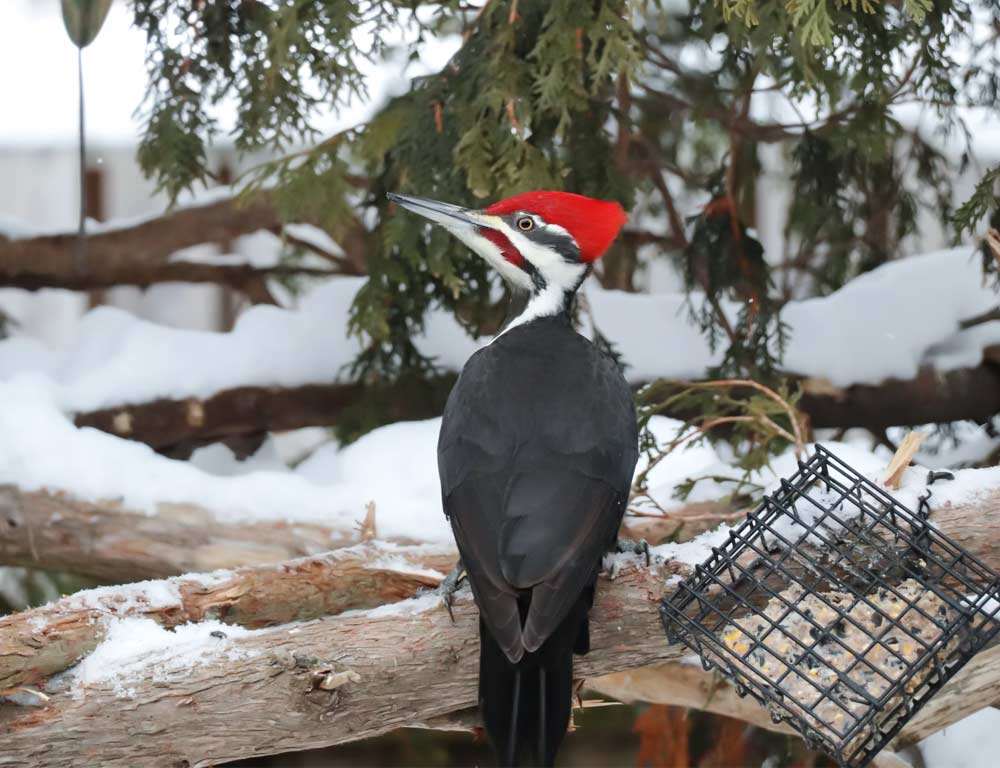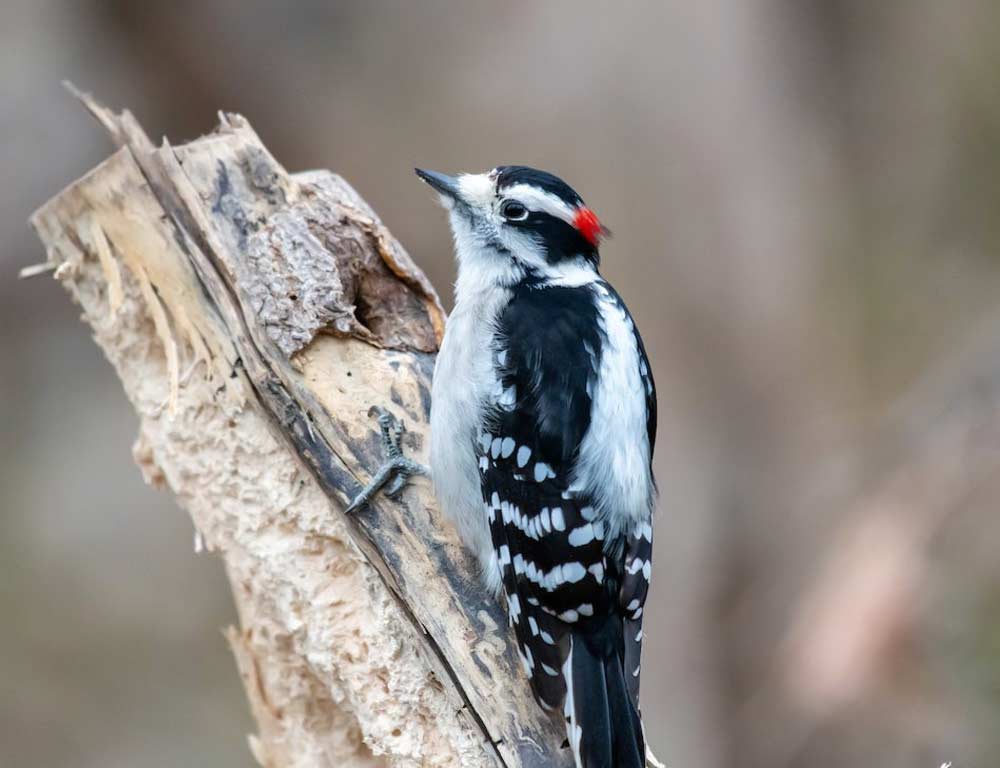Arkansas is home to a diverse avian population, boasting a variety of woodpeckers that contribute to the state’s rich birdwatching experience.
Eight distinct woodpecker species inhabit the Natural State, each with its unique characteristics and habits.
These captivating birds play a crucial role in the ecosystem by foraging for insects and larvae, aiding in pest control, and maintaining the ecological balance of Arkansas’ forests.
From the striking Pileated Woodpecker with its vibrant red crest to the diminutive Downy Woodpecker often found in suburban areas, the woodpeckers of Arkansas showcase the state’s biodiversity.
Bird enthusiasts and nature lovers alike can observe these fascinating creatures as they drum on trees, excavate nests, and add vibrancy to Arkansas’ picturesque landscapes.
Common Characteristics of Woodpeckers of Arkansas
Woodpeckers in Arkansas exhibit a set of common characteristics that distinguish them within the avian community. These traits contribute to their unique behaviors and adaptations for survival:
Specialized Anatomy
Woodpeckers have strong, chisel-shaped bills that enable them to drill into trees effortlessly. This adaptation is crucial for accessing insects beneath the bark and excavating nest cavities.
Zygodactyl Feet
Woodpeckers have two toes pointing forward and two backward, a zygodactyl arrangement. This foot structure enhances their grip on vertical surfaces, facilitating climbing and perching on trees.
Vibrant Plumage
Many woodpecker species in Arkansas showcase distinctive plumage featuring a combination of bold colors and patterns. This serves both aesthetic and functional purposes, aiding in camouflage and species recognition.
Drumming Behavior
Woodpeckers communicate through drumming, a rhythmic tapping on trees. This serves various purposes, including establishing territory, attracting mates, and signaling other woodpeckers.
Ant-Eating Specialists
A significant portion of a woodpecker’s diet consists of ants, and their specialized tongues are equipped with barbs and sticky saliva to extract these insects from tree crevices.
Tree Excavation
Woodpeckers create cavities in trees for nesting and roosting. These excavations are essential for reproduction and provide shelter for various other wildlife species.
Head Stabilization
Woodpeckers have a unique shock-absorbing system to prevent brain injury during intense drumming and drilling. This includes a spongy bone structure surrounding the brain and a specialized tongue that cushions.
Understanding these common characteristics sheds light on the fascinating adaptations that enable woodpeckers to thrive in the diverse ecosystems of Arkansas.
8 Woodpeckers of Arkansas
Arkansas hosts a vibrant array of woodpeckers, with eight distinct species enriching the state’s avian tapestry.
From the majestic Pileated Woodpecker to the charming Downy Woodpecker, these birds contribute to the ecological balance and offer birdwatchers an exciting glimpse into Arkansas’ diverse wildlife.
1. Pileated Woodpecker

- Scientific Name: Dryocopus pileatus
- Category: Large Woodpecker
- Population: Stable
- Life Span: Up to 12 years
- Size: 16-19 inches
- Weight: 8-12 ounces
- Food: Insects, fruits, nuts
- Wingspan: 26-30 inches
- Status: Least Concern
With its striking appearance, the Pileated Woodpecker boasts a vibrant red crest and distinctive black and white plumage. Known for its powerful drumming and loud calls echoing through forests, this species thrives in mature woodlands.
Pileated woodpeckers forage for carpenter ants and other insects in dead or decaying trees, using their strong bills to excavate large, rectangular holes.
Their large size and impressive wingspan make them an awe-inspiring sight in Arkansas’ wooded areas. Pileated woodpeckers are monogamous and create nesting cavities in trees, contributing to the ecosystem by promoting natural decay processes.
2. Red-headed Woodpecker

- Scientific Name: Melanerpes erythrocephalus
- Category: Medium-sized Woodpecker
- Population: Declining
- Life Span: Up to 9 years
- Size: 7.5-9.1 inches
- Weight: 2.0-3.2 ounces
- Food: Insects, seeds, nuts
- Wingspan: 16.5 inches
- Status: Near Threatened
The Red-headed Woodpecker is distinguished by its vibrant crimson head and striking black and white plumage. Often found in open woodlands and savannas, these birds are agile fliers and adept at catching insects mid-air.
Red-headed woodpeckers store surplus food by wedging it into crevices or bark, exhibiting a unique behavior among woodpecker species.
Their declining population is attributed to habitat loss and competition for nesting sites, making conservation efforts crucial for their survival in Arkansas.
3. Downy Woodpecker

- Scientific Name: Picoides pubescens
- Category: Small Woodpecker
- Population: Stable
- Life Span: Up to 6 years
- Size: 5.5-7.1 inches
- Weight: 0.7-1.0 ounces
- Food: Insects, seeds, berries
- Wingspan: 9.8-12.2 inches
- Status: Least Concern
The Downy Woodpecker, the smallest of Arkansas’ woodpeckers, is easily identified by its black and white plumage and small size.
These birds are adaptable and frequent backyard feeders commonly found in urban and suburban areas. Downy woodpeckers utilize their short bills to extract insects from tree bark and are known for their rhythmic drumming patterns.
With a stable population, they contribute to pest control by preying on harmful insects. Despite their diminutive size, Downy Woodpeckers play a significant role in maintaining ecological balance in Arkansas’ diverse habitats.
4. Red-bellied Woodpecker

- Scientific Name: Melanerpes carolinus
- Category: Medium-sized Woodpecker
- Population: Increasing
- Life Span: Up to 9 years
- Size: 9-10.5 inches
- Weight: 2.0-3.2 ounces
- Food: Insects, fruits, nuts, seeds
- Wingspan: 13-16 inches
- Status: Least Concern
Despite its name, the Red-bellied Woodpecker features only a faint reddish hue on its belly. Its striking zebra-like back pattern and vibrant head coloring make it easily recognizable.
Found in various habitats, from woodlands to suburban areas, these adaptable birds forage on trees for insects, fruits, and nuts. Red-bellied woodpeckers are proficient climbers, using their strong bills to extract prey from bark.
Known for storing food in crevices, they contribute to the ecosystem by dispersing seeds. With a population on the rise, these woodpeckers are thriving in the diverse landscapes of Arkansas.
5. Ivory-billed Woodpecker

- Scientific Name: Campephilus principalis
- Category: Large Woodpecker
- Population: Critically Endangered (Possibly Extinct)
- Life Span: Unknown
- Size: 19-20 inches
- Weight: 1.6-1.9 pounds
- Food: Insects, larvae, wood-boring beetles
- Wingspan: 30-31 inches
- Status: Critically Endangered
The Ivory-billed Woodpecker, one of the most elusive and iconic species, is believed to be possibly extinct. Once inhabiting old-growth forests, particularly in the southern United States, sightings are exceedingly rare.
Known for its distinct ivory-colored bill and large size, these woodpeckers primarily fed on wood-boring beetles.
The decline in their population is attributed to habitat loss and logging. Despite extensive efforts to locate them, confirmed sightings have been scarce, and the Ivory-billed Woodpecker remains a symbol of conservation urgency.
6. Red-cockaded Woodpecker

- Scientific Name: Picoides borealis
- Category: Small Woodpecker
- Population: Declining
- Life Span: Up to 10 years
- Size: 7-9 inches
- Weight: 1.6-2.0 ounces
- Food: Insects, spiders
- Wingspan: 13-16 inches
- Status: Near Threatened
The Red-cockaded Woodpecker is a small, black-and-white bird with a distinctive red “cockade” (spot) on the side of its head. Preferring mature pine forests, they create cavities in living pine trees, relying on resin to deter predators.
This species faces habitat loss due to logging and fire suppression, leading to a declining population. Red-cockaded woodpeckers play a vital role in maintaining the health of pine ecosystems by foraging on insects harmful to pine trees.
Conservation efforts, including habitat restoration and artificial cavity installations, are crucial for the survival of this Near Threatened species in Arkansas.
7. Northern Flicker

- Scientific Name: Colaptes auratus
- Category: Medium-sized Woodpecker
- Population: Stable
- Life Span: 6-11 years
- Size: 11-14 inches
- Weight: 3-5 ounces
- Food: Insects, fruits, seeds
- Wingspan: 17-21 inches
- Status: Least Concern
The Northern Flicker, a distinctive woodpecker species, exhibits a colorful plumage with a prominent black crescent on its chest.
Found in various habitats, including open woodlands and suburban areas, these birds are ground foragers, often searching for ants and beetles.
Their feeding habits include probing the soil with their slightly curved bills. Northern Flickers are known for their unique behavior of drumming on metal objects, resonating a loud, rhythmic sound during courtship displays.
These woodpeckers also nest in tree cavities or abandoned burrows, contributing to the overall biodiversity in Arkansas with their adaptable lifestyle.
8. Yellow-bellied Sapsucker

- Scientific Name: Sphyrapicus varius
- Category: Medium-sized Woodpecker
- Population: Stable
- Life Span: 4-7 years
- Size: 7.5-9.1 inches
- Weight: 1.5-2.1 ounces
- Food: Sap, insects, fruits
- Wingspan: 13-16 inches
- Status: Least Concern
The Yellow-bellied Sapsucker, with its intricate black and white plumage and a distinctive red throat, is known for its unique feeding habits. Unlike other woodpeckers, they drill small holes in trees to feed on sap, creating “sap wells” that attract insects.
These sapsuckers feed on the sap and insects drawn to it. Found in various wooded habitats, including forests and orchards, these migratory woodpeckers shape the structure of tree communities.
They also forage on fruits and insects, contributing to the overall ecological balance in Arkansas. The stable population of Yellow-bellied Sapsuckers highlights their successful adaptation to diverse environments.
How to Increase the Number of Woodpeckers in Arkansas
Increasing the number of woodpeckers in Arkansas requires a thoughtful approach that addresses their habitat needs and environmental considerations. Here are six descriptive points to guide efforts:
Preserve and Restore Habitat
Ensure the preservation and restoration of suitable woodpecker habitats, focusing on diverse ecosystems such as mature forests with ample dead or decaying trees for nesting and foraging.
Provide Nesting Opportunities
Install artificial nest boxes designed for woodpeckers in areas where natural nesting sites may be scarce.
These boxes should mimic the characteristics of natural tree cavities, offering a secure and attractive space for woodpecker reproduction.
Promote Biodiversity
Foster a diverse ecosystem by planting native trees and vegetation that attract insects, a primary food source for woodpeckers. This enhances the environment’s overall health and supports the woodpecker’s dietary needs.
Limit Pesticide Use
Minimize the use of pesticides in woodpecker habitats to protect their insect prey. Pesticides can harm the woodpecker’s food sources and indirectly impact their population.
Educate the Public
Raise awareness about the importance of woodpeckers in maintaining ecological balance.
Engage local communities in bird-friendly practices, encouraging responsible pet ownership and reducing disturbances in woodpecker habitats.
Collaborate with Conservation Organizations
Work with conservation groups to implement and support initiatives focusing on woodpecker conservation.
These partnerships can amplify efforts, leverage resources, and promote sustainable practices beneficial to woodpecker populations in Arkansas.
Wrapping Up
Fostering a thriving woodpecker population in Arkansas demands a holistic conservation strategy.
By preserving habitats, providing nesting solutions, promoting biodiversity, minimizing pesticide use, educating communities, and collaborating with conservation organizations, we can enhance the prospects for these captivating birds.
The woodpeckers contribute to the state’s ecological equilibrium and offer bird enthusiasts the joy of witnessing nature’s intricate balance in action.
As stewards of our environment, our collective responsibility is to ensure the continued vibrancy of Arkansas’ woodpecker community, celebrating their unique role in the state’s diverse avian landscape.